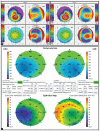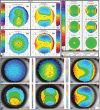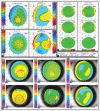Advanced epithelial mapping for refractive surgery
- PMID: 33229657
- PMCID: PMC7856960
- DOI: 10.4103/ijo.IJO_2399_20
Advanced epithelial mapping for refractive surgery
Abstract
One of the leading challenges in refractive surgery today is the presence of underlying subclinical early-stage keratoconus (KC), which can lead to iatrogenic post laser in situ keratomileusis ectasia. Timely detection of this condition could aid the refractive surgeons in better decision-making. This includes being able to defer refractive surgery in subclinical cases as well as providing treatment for the same in the form of appropriate corneal collagen crosslinking treatments. Corneal topography is considered the gold standard for the diagnosis of corneal ectatic disorders. However, there is a likelihood that topographers are overlooking certain subclinical cases. The corneal epithelium is known to remodel, which may mask underlying stromal irregularities. Imaging and analyzing corneal epithelium and stroma independently will undoubtedly open newer avenues to supplement our understanding of postrefractive surgery outcomes and KC. This review encapsulates the various Optical coherence tomography-based epithelial mapping devices particularly RTVue (Optovue, Fremont, USA) and MS-39 (Costruzione Strumenti Oftalmici, Florence, Italy) in terms of their utility in these conditions. It will help guide the clinician on how including an epithelial mapping in clinical practice can aid in diagnosis, management, and interpretation of outcomes both for refractive surgery as well as KC.
Keywords: Epithelial mapping; keratoconus; preferred practices; refractive surgery.
Conflict of interest statement
None
Figures










References
-
- Goebels S, Eppig T, Wagenpfeil S, Cayless A, Seitz B, Langenbucher A. Complementary keratoconus indices based on topographical interpretation of biomechanical waveform parameters: A supplement to established keratoconus indices? Comput Math Methods Med. 2017;2017:5293573. doi: 10.1155/2017/5293573. - PMC - PubMed
-
- Ambrósio R, Jr, Dawson DG, Salomão M, Guerra FP, Caiado AL, Belin MW. Corneal ectasia after LASIK despite low preoperative risk: Tomographic and biomechanical findings in the unoperated, stable, fellow eye. J Refract Surg. 2010;26:906–11. - PubMed
Publication types
MeSH terms
LinkOut - more resources
Full Text Sources

